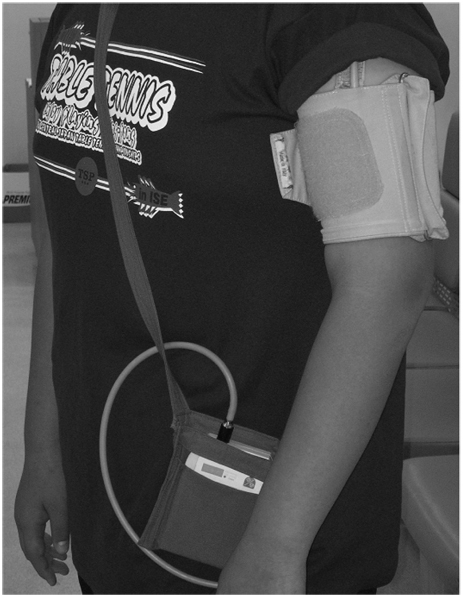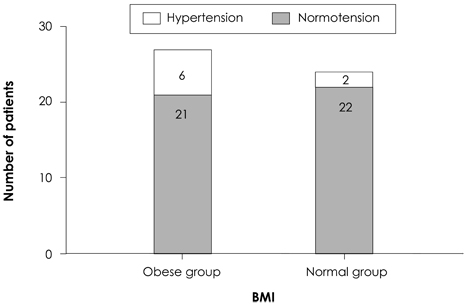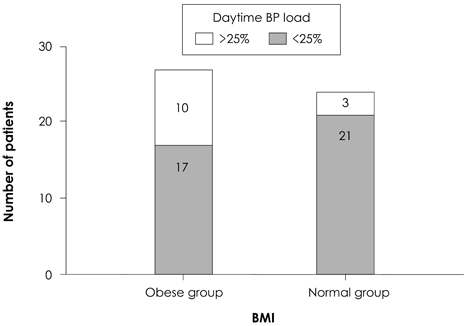Korean Circ J.
2009 Nov;39(11):482-487. 10.4070/kcj.2009.39.11.482.
Ambulatory Blood Pressure Monitoring and Blood Pressure Load in Obese Children
- Affiliations
-
- 1Department of Pediatrics, Sunlin Hospital, Pohang, Korea.
- 2Department of Pediatrics, Sejong Hospital, Bucheon, Korea. amyjys@naver.com
- KMID: 2225651
- DOI: http://doi.org/10.4070/kcj.2009.39.11.482
Abstract
- BACKGROUND AND OBJECTIVES
This study was aimed at evaluating the significance of blood pressure (BP) load in ambulatory blood pressure monitoring (ABPM) in obese children and adolescents.
SUBJECTS AND METHODS
ABPM was conducted for 60 selected patients who had visited Sunlin Hospital between January 2008 and August 2008. Patients were classified into 3 groups; an obese group whose body mass index (BMI) was > the 95th percentile, an overweight group whose BMI was > the 85th percentile but less than the 95th percentile, and a normal group whose BMI was below the 85th percentile. Overall mean BP, day and night BP and BP load were measured by ABPM.
RESULTS
Of the 60 patients, twenty-seven children belonged to the obese group, 9 and 24 to the overweight and the normal group, respectively. Among the three groups, the overall average systolic and diastolic BP, daytime diastolic BP, and systolic BP loads in daytime and nighttime were statistically different. Comparing the obese group with the normal group, systolic BP loads in daytime and nighttime in the obese group were significantly higher than those in the normal group. Also, the obese group had more patients whose BP loads were over 25% greater than the normal group while the difference in the number of patients with overall hypertension was not significantly different.
CONCLUSION
Assessment of children's BP through assessment of BP load is a more detailed and precise tool than assessment through mean BP using ABPM and BP can be better controlled using measurement of BP load.
MeSH Terms
Figure
Reference
-
1. Oh KY, Jang MJ, Lee NY, et al. Prevalence and trends on obesity among Korean children and adolescents in 1997 and 2005. Korean J Pediatr. 2008. 51:950–955.2. Ogden CL, Flegal KM, Carroll MD, Johnson CL. Prevalence and trends in overweight among US children and adolescents, 1999-2000. JAMA. 2002. 288:1728–1732.3. Ogden CL, Carroll MD, Curtin LR, McDowell MA, Tabak CJ, Flegal KM. Prevalence of overweight and obesity in the United States, 1999-2004. JAMA. 2006. 295:1549–1555.4. Lauer RM, Burns TL, Clarke WR, Mahoney LT. Childhood predictors of future blood pressure. Hypertension. 1991. 18:3 Suppl. I74–I81.5. Chu NF, Rimm EB, Wang DJ, Liou HS, Shieh SM. Clustering of cardiovascular disease risk factors among obese schoolchildren:the Taipei Children Heart Study. Am J Clin Nutr. 1998. 67:1141–1146.6. Must A, Jacques PF, Dallal GE, Bajema CJ, Dietz WH. Long-term morbidity and mortality of overweight adolescents:a follow-up of the Harvard Growth Study of 1922 to 1935. N Engl J Med. 1992. 327:1350–1355.7. Gunnell DJ, Frankel SJ, Nanchahal K, Peters TJ, Davey Smith G. Childhood obesity and adult cardiovascular mortality: a 57-y follow-up study based on the Boyd Orr cohort. Am J Clin Nutr. 1998. 67:1111–1118.8. Park CG. Obesity and cardiovascular disease. Korean Circ J. 1997. 27:130–134.9. He Q, Ding ZY, Fong DY, Karlberg J. Blood pressure is associated with body mass index in both normal and obese children. Hypertension. 2000. 36:165–170.10. Pickering TG, Shimbo D, Haas D. Ambulatory blood-pressure monitoring. N Engl J Med. 2006. 354:2368–2374.11. Kim MJ, Song JY. The utility of ambulatory blood pressure monitoring in obese children. Korean J Pediatr. 2008. 51:604–609.12. Sorof JM, Portman RJ. Ambulatory blood pressure measurements. Curr Opin Pediatr. 2001. 13:133–137.13. O'Shea JC, Califf RM. 24-hour ambulatory blood pressure monitoring. Am Heart J. 2006. 151:962–968.14. Moon JS, Lee SY, Nam CM, et al. 2007 Korean National Growth Charts: review of developmental process and an outlook. Korean J Pediatr. 2008. 51:1–25.15. Lee CG, Moon JS, Choi JM, et al. Normative blood pressure references for Korean children and adolescents. Korean J Pediatr. 2008. 51:33–41.16. Kim CH. Ambulatory blood pressure monitoring. Korean Circ J. 1997. 27:1218–1221.17. Lee KH, Shin GJ, Cho HK. The correlation between LVH, LV function and 24-hour ambulatory blood pressure monitoring in patients with newly diagnosed hypertension. Korean Circ J. 1997. 27:712–720.18. Hansen ML, Gunn PW, Kaelber DC. Underdiagnosis of hypertension in children and adolescents. JAMA. 2007. 298:874–879.19. Sorof JM, Lai D, Turner J, Poffenbarger T, Portman RJ. Overweight, ethnicity, and the prevalence of hypertension in schoolaged children. Pediatrics. 2004. 113:475–482.20. Lurbe E, Torro I, Alvarez V, et al. Prevalence, persistence, and clinical significance of masked hypertension in youth. Hypertension. 2005. 45:493–498.21. Stabouli S, Kotsis V, Toumanidis S, Papamichael C, Constantopoulos A, Zakopoulos N. White-coat and masked hypertension in children: association with target-organ damage. Pediatr Nephrol. 2005. 20:1151–1155.22. Maggio AB, Aggoun Y, Marchand LM, et al. Associations among obesity, blood pressure, and left ventricular mass. J Pediatr. 2008. 152:489–493.23. Diaz LN, Garin EH. Comparison of ambulatory blood pressure and Task Force criteria to identify pediatric hypertension. Pediatr Nephrol. 2007. 22:554–558.24. Soergel M, Kirschtein M, Busch C, et al. Oscillometric twenty-four-hour ambulatory blood pressure values in healthy children and adolescents: a multicenter trial including 1141 subjects. J Pediatr. 1997. 130:178–184.25. Grossman E, Alster Y, Shemesh J, Nussinovitch N, Rosenthal T. Left ventricular mass in hypertension: correlation with casual, exercise and ambulatory blood pressure. J Hum Hypertens. 1994. 8:741–746.26. White WB, Dey HM, Schulman P. Assessment of the daily blood pressure load as a determinant of cardiac function in patients with mild-to-moderate hypertension. Am Heart J. 1989. 118:782–795.27. Tsioufis C, Stefanadis C, Goumas G, Pitsavos C, Toutouzas P. Relation of ambulatory blood pressure load with left ventricular geometry in untreated patients with mild-to-moderate hypertension. J Hum Hypertens. 1999. 13:677–682.28. Sorof JM, Portman RJ. White coat hypertension in children with elevated casual blood pressure. J Pediatr. 2000. 137:493–497.
- Full Text Links
- Actions
-
Cited
- CITED
-
- Close
- Share
- Similar articles
-
- The utility of ambulatory blood pressure monitoring in obese children
- Diurnal Variation of Blood Pressure; the Difference between before and after Removal of Pheochromocytoma: Evaluation by Ambulatory Blood Pressure Monitoring
- Comparison of Blood Pressure Control and Left Ventricular Hypertrophy in Patients on Continuous Ambulatory Peritoneal Dialysis (CAPD) and Automated Peritoneal Dialysis (APD)
- Clinical Significance of Nighttime Blood Pressure
- Clinical Usefulness of Ambulatory Blood Pressure Monitoring in Children and Adolescents




